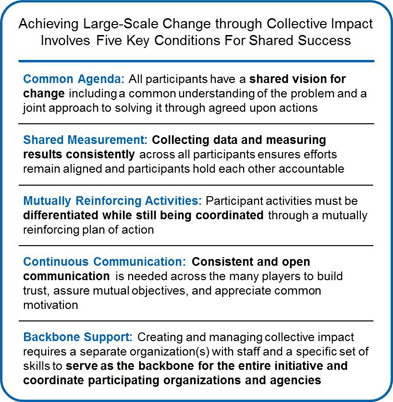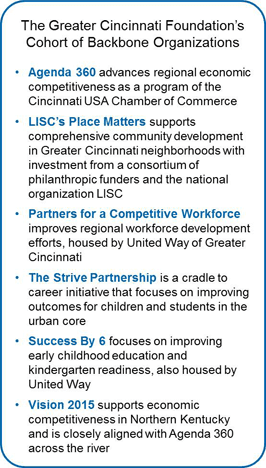The Greater Cincinnati Foundation (GCF) and the nonprofit consulting firm FSG have partnered to understand and evaluate the role of backbone organizations in collective impact efforts. The first in a four-part series, this blog post describes the foundation’s motivations for funding backbone organizations, and for GCF and FSG’s work.
Making a Commitment to Strengthen Backbone Organizations
Communities and organizations around the world are adopting a different mindset to achieve large-scale systemic change through collective impact, a concept that was first introduced in the winter 2011 issue of Stanford Social Innovation Review and more recently discussed on the Stanford Social Innovation Review blog. As cross-sector groups engage more deeply in this practice, funders and practitioners alike find ourselves probing for answers to the question: How do you do this work well?

In Cincinnati, the collective impact model is a living, breathing—and evolving—practice. The community has embraced this approach to accelerating change across systems. And the community’s leaders are committing to making this ambitious work succeed.
GCF is leading the way for collective impact in the region. As a funder, GCF believes that providing “backbone support” (see chart) which propels collective impact efforts is critically important. The foundation has taken a bold, if not “sexy,” step by investing in the support infrastructure of collective impact—the backbone organization itself—to accelerate change. If the Foundation is to succeed, everyone must understand what backbone organizations are and how they can be most effective.
In January 2012, GCF and FSG began exploring four big questions with a cohort of the region’s backbone organizations:
- How and to what extent are backbone organizations effective catalysts for achieving community-level progress?
- How and to what extent do backbone organizations contribute to improved social outcomes?
- How is success best measured for backbone organizations?
- What common challenges and best practices can be shared across backbone organizations?
In this series of posts, we share our experience to help funders see backbone support as a strategy to advance collective impact initiatives. We hope to build a common language and understanding for the role and value of backbone organizations so that all partners in a collective impact effort can articulate the need for and the importance of this vital element, and ensure the overall success of an initiative.
Cincinnati’s “New Normal”
In Cincinnati, collaboration is the “new normal,” but this was not always the case. Like many regions, individual organizations and initiatives were doing important and effective work. But the overall economy still lagged behind its peers around the country. For this community, the collective impact model developed, almost organically, as organizations convened collaboratives and coalitions to invent more effective methods for creating powerful and lasting social change. Over the last 10 years or so, many strong backbone organizations were created to coordinate community initiatives and accelerate change. GCF played an important role in funding, incubating, or otherwise supporting many of these initiatives.
As an anchor institution, GCF has taken the long view on complex social problems when few others could; it has evidence that progress can be made when the community sticks with large-scale initiatives. Supporting collective impact has been a natural evolution in GCF’s community leadership. The Foundation believes that, by providing change capital to a group of backbone organizations, it will be able to accelerate progress toward social change in the region.
GCF and FSG’s Work Together
In addition to a leveraged, multi-year funding strategy, GCF chose to invest in evaluating the work of a cohort of backbone organizations and in creating a community of practice among them. Using this approach, regardless of sector or issue, these organizations would learn from each other, continuously improve their practice, and encourage greater collaboration across overlapping initiatives. GCF engaged FSG to assist in this work. As a nonprofit strategy, evaluation, and research consulting firm, FSG believes evaluation is a powerful way to inform strategy and help organizations learn. The firm’s strategic learning and evaluation practice helps individual organizations and groups design and implement program evaluations, shared measurement systems, and organizational evaluation systems.

In early 2012, GCF and FSG began a partnership built around evaluating backbone effectiveness and answering the above four questions. GCF selected six backbone organizations (see text box) to participate that are all beyond the initial “start-up” phase of forming their collective impact initiatives, and are refining and sustaining their initiatives. They all have at least one full-time staff person, but operate using a lean staffing model and mobilize many partners to help further their work. While the issue areas they address have some overlap, there are clear differences in the breadth and depth of the initiatives, the scope of the backbone organizations’ role, and the context in which they do their work.
GCF’s Challenge
The work of a backbone organization is complex. The roles played in accelerating change can be challenging to articulate as, by design, their work is largely behind the scenes. Therefore, GCF’s new approach to community leadership means that evaluating and communicating the value of backbone organizations has become all the more important. In addition, defining and communicating what “effectiveness” really means is another driver of the Foundation’s work. The backbone organization is an emerging concept necessary to the collective impact approach. GCF needs to paint a clear picture for stakeholders—board members, staff, donors, volunteers, current and potential grant recipients—of what success looks like and why this strategy is ultimately worth pursuing. This is the challenge and task before us.
Follow our story over the next three posts, as we share our process, results, and next steps for tackling this work.
Support SSIR’s coverage of cross-sector solutions to global challenges.
Help us further the reach of innovative ideas. Donate today.
Read more stories by John Kania, Shiloh Turner, Kathy Merchant & Ellen Martin.

